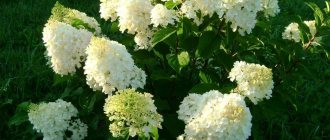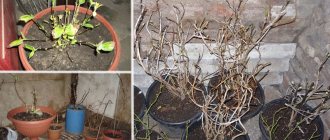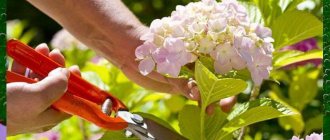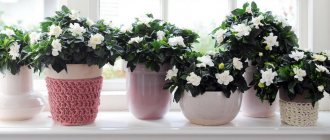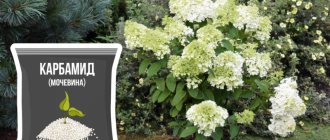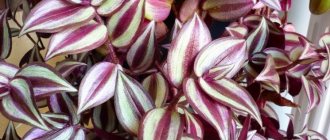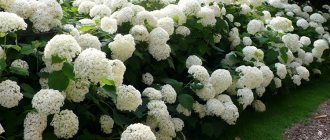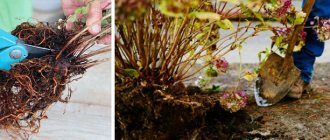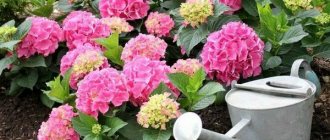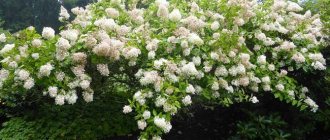Hydrangea (Hydrangea)
Hydrangea (Hydrangea) is liked by many gardeners for its lush color and ability to winter in open ground. The inflorescences continue to delight the eye from July to October. Most types of hydrangea have white flowers, but there are varieties with cream, red, lilac and pink flowers. Moreover, color often depends not so much on the variety as on the composition of the soil.
Types and varieties of indoor hydrangea
Hydrangea is a plant whose height reaches one and a half meters. Belongs to the type of subshrubs. Has spreading leaves. They have small notches along the very edge. It is distinguished by very large inflorescences that reach up to 30 cm in length.
Varieties have been bred to create a large palette of colors. Let's look at the most common ones for home floriculture.
- Tree-like. A shrub whose height reaches 3 meters. The leaves are large and fleshy. Bright green hue. The flowers form a spherical sphere and reach a diameter of 25 cm. Flowers are most often colored milky or beige. One of the most unpretentious varieties.
- Large-leaved. The length reaches 2 meters. Suitable for both home growing and greenhouse growing. The leaves are quite large. The shoots are always light green. The variety is resistant to cold, so even in the winter season it feels great on a cold window.
- Paniculata. Looks like a large spreading shrub or small tree. The height reaches 6 meters. The leaves have an elongated shape. And the shoots turn brown with age. The plant is resistant to cold. The inflorescences gradually form a small pyramid. They have shades from milky to blue. By autumn, the flowers acquire a reddish or even brown tint.
Flowers also differ in the color that is inherent in them during flowering. There are varieties:
- red sensation;
- Early Blue;
- Europe;
- star;
- linear and so on.
However, the color of the inflorescences is affected not only by the variety, but also by the composition of the soil. For example, if it is sour, then a blue tint appears in the flowers. If it is more alkaline, then the pigment is pink or red. If the soil is neutral, then you will get boiling white flowers with milky splashes.
Varieties of indoor hydrangea
Large leaf hydrangea has many varieties. The most common ones are divided by color:
| Colors | Variety | Description | Inflorescences Features of flowering |
| Light shades | Sister Therese (Soeur Therese) | The bush is quite dense and large-leaved. | Painted white with a slightly pinkish-lilac sheen, about 30 cm. Abundant, continues until September. As the inflorescences wilt, they change color and become greenish-pink. |
| Madame Emile Mouillere | Compared to various other varieties, the leaf blades are narrower. | 20 cm, and the color is white. At first they are white, but then they become slightly pinkish and bluish. Flowering is numerous and continues until October. | |
| Blue | Early Blue | The shrub is small, but its root system is quite strong. | Reaches 30 cm. Their color is blue, as well as blue and purple shades. Slightly greenish at first. Abundant and lasts until October. |
| Nikko Blue | For bright flowers, it is necessary to maintain soil acidity at 5.5–7.0 pH. The bush will grow quite quickly. | Approximately 30 cm. The color of the flowers is bright blue. Very abundant until September or October. | |
| Pink | Ramars Mars | The size of the bush is not very large. | They are painted in a pinkish-raspberry hue, and edged with white. 30 cm despite the small size of the bush. Continues until September. |
| Miss Saori | The leaf blades are dark green in color and have a slight purple tint. | 18 cm. Snow-white, framed with a pinkish border. The condition of the soil does not affect the color. This variety blooms until September. | |
| You and my love (You&me Love) | Reaches 100 cm in height. The leaves are resistant to powdery mildew. Withstands temperatures of +29 °C. | If the soil is alkaline, the color will be pink, and if it is acidic and contains a lot of aluminum, the color will be blue. Starts in May and ends in September. | |
| Reds | Admiration | The crown of the bush is quite dense. | 20 cm, bright red. Abundant, right up to the first frost. |
| Multicolor | Bavaria | Compact and small in size. | 20 cm have a lime color, the middle with a bluish-violet tint. Rich until mid-autumn. |
| Hot Red | A bush with small inflorescences, very lush. | 15 cm. Scarlet, but if there is a strong increase in soil acidity, they acquire a purple color. Continues until October. | |
| Schloss Wackerbarth | Flowers of this variety have light stamens. | They can reach 30 cm in size. At the very beginning of flowering, their color is green, and then turns pink, with a blue center and green edging appearing. Until October, sometimes until early November. |
How to choose hydrangea in a store
It is believed that it is better to purchase flowers in specialized stores.
The first thing to do is look at the stem. It should be dense, elastic, and have an expensive green color. There should be no brown or yellow growths on the leaves. They should be juicy and bright green. If the hydrangea leaves are limp, dry at the edges, or have white or yellow spots on them, you should refuse to purchase.
Carefully examine the hat of flowers. It should be dense, rich, bright colors. If the cap is pale, and the flowers begin to fall when touched lightly, it means that the plants did not receive enough nutrients.
There is one general rule that should be applied to choosing a flower - it should look healthy, nourished and moisturized.
Paniculata hydrangea
It can grow as a large bush up to three meters in height or as a ten-meter tree on a trunk. It all depends on how to form the crown. Buds appear in the second half of summer, the inflorescences acquire an elongated cone-shaped shape. There are also early varieties, the representatives of which bloom already in June.
A special feature of paniculate hydrangea is the ability to change the color of flowers throughout the season. For example, at the beginning they may be whitish, and by the end - transparent light green. This type of plant has pyramidal inflorescences with a wide base. The buds are most often white, lilac, pink or burgundy. Every year, breeders develop new varieties. Among them, it is worth noting the Kyushu hydrangea, which is the only one of its kind that has a scent.
This species is the most frost-resistant and unpretentious. If you know how to care for paniculate hydrangea in the country, then planting it will definitely be a success.
Care and replanting after purchase
It is not recommended to replant hydrangea immediately after purchase. The plant must get used to new conditions. Give her 2 weeks to 1 month to adapt.
In the future, the transplant procedure should be carried out at least once every 3–4 years.
If you ensure annual replanting into larger pots, you can ensure the fullest blooms your hydrangea can produce. The roots of the plant grow in width, so the volume of the pot must match.
Choose a pot that is slightly larger than the diameter of the one you purchased the flower in.
While the plant adapts, you can gradually acquire components for the substrate. You will need 1 part sand, two parts peat, two parts deciduous soil and 4 parts turf soil. All this is mixed and poured into the pot.
Do not forget that during the first stages of life in a new room, hydrangeas will require additional care in the form of fertilizing. It is better to buy mineral fertilizer intended specifically for indoor flowering plants. You can buy it in a specialized store. It is important not to overdo it, so dilute the fertilizer according to the instructions and water the flower in the amount indicated on the package.
Hydrangea does not like direct sunlight, but loves warmth and diffused light. Therefore, it is better to place it on a shaded window.
As soon as the hydrangea gets stronger, you can take care of it and replant it.
At first after purchase, namely, the first two weeks, it is better not to overwater the plant. It is necessary to moisten the soil as it dries. But spraying leaves and flowers from a spray bottle is highly recommended. This procedure must be performed once every two days.
Planting indoor hydrangea
Indoor hydrangea usually lives for about four years.
In addition, it should be replanted annually, because it grows and requires more space for itself. The pot for this should not be too deep. The main thing is that it be wide, due to the fact that the roots of this flower grow in breadth. Each new container should be approximately 1.5 times larger than the previous one.
A large and beautiful hydrangea can be obtained by growing it in suitable soil, taken in the ratio (0.5: 1: 1: 2):
- sand;
- peat;
- leaf soil;
- turf.
Compost cannot be added because it negatively affects the root system of the flower.
Indoor hydrangea experiences stress from transplantation, which has a bad effect on its development in the future. To help you survive this event as best as possible, you need to use the transshipment method. At the bottom of the pot in which the plant will be placed, you need to place a sufficient amount of drainage. After this, place the flower in a flowerpot and then fill all the free space with fresh substrate. It should turn out that the root collar of the hydrangea will be flush with the soil surface.
Afterwards, you need to moisten the soil and sprinkle a little peat mulch on top. This helps maintain sufficient moisture in the soil.
Caring for hydrangea at home
Lighting for indoor hydrangea
If you choose the right lighting for a flower, it will delight you with its color for a long time.
It is important to choose the right place here. This is necessary so that there is an abundance of color. However, the leaves and flowers of the plant should not be exposed to direct sunlight. Therefore, you need to place the flower at a distance of approximately 3–4 m from the window. In this case, the plant will feel ideal.
Temperature for hydrangea
In terms of temperature, the plant is capricious. The ideal room temperature is between 18 and 23 °C. It is ideal for hydrangeas. The plant should not be exposed to drafts, as it may die.
In winter, this flower can be placed in a room where the temperature is 10 °C. Then the hydrangea will go into a short hibernation and accumulate strength until the new summer season.
Don't forget about watering. The water used to irrigate the land must be at room temperature. Under no circumstances should you use water from the refrigerator.
Watering hydrangea
Caring for hydrangeas in terms of watering should include regularity.
- Hydrangea loves fresh water very much. It can be classified as a moisture-loving plant.
- For irrigation, settled water that is at room temperature is ideal.
- The hotter it is outside the window, the more often you need to irrigate the soil. Don't forget to spray the flowers and leaves with a spray bottle. However, you should not be overzealous with watering. It needs to be renewed as the soil dries out. If you overwater it, the hydrangea can easily rot.
- If the hydrangea leaves begin to turn yellow, this means that it lacks acid. Therefore, sometimes you need to give her a shower with acidic water. To do this, mix 5–8 drops of lemon juice in one liter of water.
Air humidity
Hydrangea loves humidity in the air. Therefore, when the heating season begins and the air is dry, the plant suffers greatly. Therefore, do not forget to spray it with a spray bottle.
If you have a humidifier, place the plant pot nearby. It is enough for hydrangea to spend about half an hour next to a humidifier to stock up on moisture for several days ahead.
Third step: choose a location on the site
When deciding how to care for hydrangea in the country, the choice of planting site is almost the most decisive. The shrub plant will show abundant flowering and good growth only in an area with good lighting. In extreme cases, partial shade can be a compromise option. But the sun's rays should still fall on the plant most of the day.
Colored varieties need light shade at midday. The optimal place would be a flowerbed at the dacha, where the sun's rays reach only until lunchtime. After this, the hydrangea should be in the shade. It is also important that the bush is protected from drafts.
Feeding
In the spring and summer, Hydrangea enters the active stage. At this stage, for enhanced growth, she will need additional amounts of useful minerals and organic substances. Therefore, it is at this stage that it is worth using organic fertilizer.
Unfortunately, if you neglect such care, the plant will stop blooming and develop further.
When watering several times a week, you need to add a few drops of potassium permanganate to the water.
Winter care does not involve the use of fertilizing.
Gardeners say that gibberellin solution is successful in caring for hydrangeas. Approximately 0.1 g per 1 liter of water is used. Thanks to the composition, hydrangea quickly enters the flowering state.
Step six: periodically loosen the soil
Now let's move on to how to care for hydrangea in the country during its active period. During the season, you need to loosen the soil around the plant twice to a depth of about six centimeters. This is best done after weeding and watering. Typically, hoe blades with long teeth are used to provide air flow to the roots.
To retain moisture, gardeners practice mulching around the tree trunk. It is recommended to use old sawdust, pine needles, peat and moss. They will save moisture and get rid of weeds. Each layer should be approximately five centimeters thick. For example, if you add mulch in the spring, it will perfectly retain its properties until the fall. Experienced gardeners prefer this method of soil care. Because it is guaranteed to free you from constant loosening and weeding. You will only need to water and fertilize.
Trimming
The pruning procedure is mandatory in order to maintain the attractive appearance of the plant. For this procedure you will need a well-sharpened knife or pruning shears. The cut should be sharp and even.
During pruning, weak leaves and stems that have begun to dry out or rot are removed. It is also necessary to trim the top of the plant in order to form a more luxuriant crown.
It is ideal to prune twice a year. This is in the fall, when the flowering period has passed, you need to remove weakened leaves and in the spring, when you need to remove weakened shoots.
During the flowering period, the pruning procedure stops. It begins when the first faded flowers or leaves appear. They are the ones that need to be removed so that the plants do not rot.
Garden hydrangea: planting and care
When planning to grow hydrangeas on a site, immediately determine the planting location. Brightly blooming hydrangeas will decorate borders and flower beds, vines will cover gazebos, and hydrangea trees will grow along the perimeter of the garden in the sunniest areas. Larisa Zarubina, the famous host of the Garden Guide website, advises choosing such places.
Growing conditions
For hydrangea to take root in a garden plot, it is not enough to choose the appropriate species and variety. It is necessary to take into account the conditions in which the hydrangea will grow and bloom throughout the season:
- open area with good lighting;
- a certain level of soil acidity, which affects color;
- watering and fertilizing regime;
- formation of shrubs and trees by pruning;
- sheltering plants for wintering.
Hydrangea is resistant to diseases and pests, so it does not require additional protection.
Conditions for growing hydrangea: Pixabay
Methods for propagating hydrangea
Beginning flower growers are interested in the question of how to propagate hydrangea, because one bush, which was purchased in a specialized market, is not enough for a live picture. Take advantage of the advice of experienced gardeners and breeders who are introducing different hydrangea propagation technologies:
- Species hydrangeas are propagated by seeds. They are sown in autumn in pots or containers. Grow for two years indoors. In the summer, they are taken out to open areas for hardening, transplanted into larger pots. In the third year of planting, seedlings grown from seeds are planted in a permanent place. A healthy seedling at this time grows up to 30–40 cm.
- It is convenient and quick to propagate by cuttings those varieties that are suitable for the garden and that the gardener likes. Cuttings are cut in mid-July from last year's green shoots. They are planted in containers filled with nutritious soil mixture. It will take a month for the cuttings to root. In the fall, cuttings in pots are left to overwinter outside, covered with leaves and straw, or kept indoors until spring.
- In early spring, hydrangeas are propagated by layering. To do this, the lower branches are sprinkled with earth, and by the end of summer several young bushes form on them at once. They are hilled up and separated from the mother bush in October. The seedlings are planted in a permanent place next season.
- By dividing the bush, you can rejuvenate and plant hydrangeas of all types, except paniculata. The bush is first dug out from the ground and divided into several parts. Delenki (part of the bush with a growing point) are immediately planted in a new place, cutting off excess roots and stems.
The gardener can always choose the appropriate method for propagating hydrangeas and plant them in the garden in 2-3 years. These and other secrets of growing hydrangea are described in the book by practicing gardener Anna Belyakova.
Hydrangea propagation: Pixabay
Rules for planting hydrangeas
In order for hydrangea to take root and soon delight you with flowering, it is planted in spring or autumn according to the following scheme:
- Choose a single or group planting.
- Leave at least 1 m between seedlings.
- Make holes 30x30x30 cm.
- Place a drainage layer of sand at the bottom of the holes.
- Add 1 tbsp. l. mineral fertilizers and 0.5 liters of peat.
- The roots of the seedlings are shortened and placed in the holes.
- Water the seedlings in the holes.
- Cover with soil and mulch with peat.
It is better to plant hydrangeas in the spring. Then the heat-loving plant will have time to take root during the summer. Hydrangeas planted in the fall are likely to freeze in winter.
Hydrangea planting rules: Pixabay
Rest period
The dormant period of hydrangea begins in the cold season. As a rule, during autumn frosts. Plants go dormant, begin to consume less moisture and stop blooming. To allow the plant to gain strength before the next season, it must be placed in a room with a temperature of no more than 10 degrees. Do not forget about watering as the soil dries out.
Hydrangea will resume its vitality in late March - early April, when the sun begins to actively warm up.
Reproduction
Hydrangea can be propagated in various ways. Some are more, some are less effective. Let's look at the nuances of each method.
Propagation by cuttings
Propagation by cuttings is the easiest way. The most favorable time for this is January or February.
Take a closer look at the root shoots. Cut the cuttings so that there are no more than three nodes on the branch. Their length should be approximately 8 cm. All leaves should be removed from the bottom of the cut root. The upper leaves should be shortened exactly by half.
The cut on the lower side must be treated with a special root stimulator, which is sold in specialized stores.
The cuttings must be planted in a specially prepared substrate, which consists of peat and sand. Provide maximum humidity, which will promote rapid root formation. Ideal temperature is up to 20 degrees.
Some housewives advise covering the cuttings with special glass jars. However, once a day you need to leave the plant to air for several hours, removing the glass protection. The plant needs constant moisture, so the soil needs to be watered and the leaves should be sprayed with a spray bottle.
After just one month, the cuttings can be planted on prepared peas.
Reproduction by dividing the bush
Dividing the bush is another common method. However, you need to act with caution so as not to spoil the entire bush.
The shoots are evenly shortened. The bush is divided into several parts, carefully freeing the roots. Parts of the plant need to be distributed into different pots into a specially prepared adversary and watered.
You can apply a mulching procedure, which is designed to root the plants faster. It is better to carry out this procedure in the spring so that by autumn the plant feels comfortable in the pot.
Propagation by seeds
When growing seeds, the procedure must be carried out already in February.
- Prepare the soil, which consists of turf and humus.
- Additionally, admixtures of peat or sand can be added to it.
- Purchase special containers that are designed for growing.
- Scatter hydrangea seeds on top. They do not need to be buried in the ground.
- Water the soil well.
- Then you need to cover the container with cling film or glass. Every day you need to ventilate the crops and moisten them with a spray bottle. Remember to keep the soil mostly moist, but not wet.
- As soon as the first shoots appear, the cling film can be removed.
When two leaves appear, they need to be picked in a container.
Reproduction by layering
This type of propagation is best done in March. Used for plants that grow in open ground. However, it can also be used for home flowers.
- The soil around is dug up and compared.
- Small grooves are made to a depth of 2 cm. Approximately one shoot is placed in them. By the way, the shoots need to be cut off from the bottom of the bush.
- They are laid parallel to the ground and covered with earth.
- Then you need to constantly spray the area with a spray bottle to achieve adequate moisture.
- As soon as the roots appear, you need to make a constriction of soft wire. It is carried out in three turns.
- The more the wire is pressed, the faster roots will appear from this place.
By the end of summer, several months after the start of reproduction, several young shoots appear on the cuttings. Once they reach a height of 20 cm, they can be transplanted into a separate pot.
Description of hydrangea
Hydrangea in open ground can grow up to 4 m, in indoor conditions - up to 1.5 m. Its leaf plates are simple and ovoid, painted bright green.
The flowers are collected in shields 10-15 cm. Along the edges there are pinkish ethereal flowers 3 cm in size. In some species, inflorescences are up to 20 cm. Their color can be pink, white, and also blue.
Diseases and pests
Hydrangea is prone to diseases, which form on it with surprising frequency.
- Gray rot. Appears on the leaves if you overdo it with moisture. Reduce watering and make it a rule to treat the flower with a special Bordeaux mixture.
- Spider mite. When the air is dry, on the contrary, spider mites or aphids appear on the plant. To destroy this scourge, you need to water the hydrangea with a soap solution or a special product from the store.
- Downy mildew. Appears at high humidity. Eliminated through the use of drugs that contain copper.
- Nematode. A nightmare for hydrangeas. If the plant is affected by more than 50%, then, unfortunately, it cannot be saved and will have to be thrown out.
Preparing for winter
Before sending the hydrangea into hibernation, it must be prepared on the eve of the onset of cold weather.
The plant cannot overwinter in Russian winter conditions without appropriate insulation. This also applies to indoor hydrangeas. You should not place hydrangea on an open balcony where the temperature is below 0 degrees. The ideal temperature for wintering hydrangea is +10 °C.
Before you prepare your hydrangea for winter, you need to do the appropriate pruning. To do this, faded flowers, dry or, conversely, too limp leaves are removed. If there are individual shoots that have grown in length but are very dry, or vice versa, they show signs of rot, they also need to be cut off.
After the procedure is completed, the plant must be brought to a new watering regime. Now you need to water less often so that the hydrangea does not rot by winter.
Prepare a room to place the flower. The temperature in it should be between 8–15 degrees, no higher and no lower. Place the plant in this room and make sure that it will not be exposed to drafts.
Tenth step: cover the hydrangea for the winter
Tree hydrangea does well without shelter. But the paniculate and large-leaved species will no longer be able to survive without it in winter. To prevent the roots from freezing, hill up with rotted manure. Some gardeners create a fifteen-centimeter protective layer of dry leaves, pine needles, moss and peat. Afterwards agrofibre is laid on it. In such “clothing” hydrangea will winter well.
It is important to remember that young plantings of any variety need to be wrapped for the winter. Because they are not yet strong enough to fight the frost. The covering is still the same - leaves and agrofibre.
Now you know how to care for hydrangea in the countryside so that it pleases everyone with its large and bright inflorescences.
Changing the color of hydrangea
Not all hydrangea owners are happy with its color. You may not know, but it's easy to change.
- Make the soil more alkaline. Then bright pink flowers will appear along with a blue or white tint.
- If you make the soil more acidic or regularly water the plants with water and a few drops of lemon juice, you can achieve a blue tint.
- If the soil is in normal condition and the plant is regularly watered with water with the addition of a small amount of potassium permanganate, then the hydrangea will acquire a white tint.
Difficulties in growing hydrangea
Leaves are drying
If the leaves of a hydrangea dry out, it means that it does not have enough moisture. Give preference to watering with a spray bottle, which should be done daily. Also, do not forget about ventilating the room.
Watering should be done as the soil dries out. Turn on a humidifier near the hydrangea for several hours.
The leaves are falling
If leaves fall, then, unfortunately, this is also evidence of improper care. Falling from dryness indicates a lack of moisture and the proper amount of nutrients.
If the leaves simply wither and fall off, most likely the hydrangea is not getting enough sunlight and warmth. Therefore, raise the room temperature to the desired level.
What to do if the hydrangea has withered
If the hydrangea has wilted by 40%, you can try to revive it. To do this, water it with water containing potassium permanganate. Additionally, copper sulfate and other fertilizers are diluted and poured into the soil.
If it was not possible to rehabilitate the hydrangea, you should say goodbye to it. And the housewife needs to analyze what caused the plant to wither so quickly.
Hydrangea does not bloom, what to do
The plant will bloom if the following conditions are met.
- When the rest period ends.
- It was properly prepared for winter.
- Receives the proper amount of nutrition and feeding.
- All flower diseases were removed.
If you missed any of these points, then, most likely, this is why the hydrangea does not bloom. However, the reason may lie in completely different factors. For example, the roots were damaged during transplantation. The plant directs all its forces to restore their integral structure and not wither. Therefore, flowering is temporarily delayed.
Many people call hydrangea a capricious plant. After all, to care for it you need to very correctly select the necessary standards for temperature and humidity indicators. However, a housewife who is not afraid to mess with hydrangea and is ready to care for it both summer and winter can decorate her home with an incredible color that will delight you all spring, summer and autumn.
Types of hydrangeas with photos and names
Hydrangea growing and care in the garden
Taxonomists call up to 80 different varieties of the autumn beauty hydrangea. When most flowers lose their decorative properties, the time comes for hydrangea, which blooms lush inflorescences in late summer and autumn. It saturates the autumn palette with bright hats of flowers, enlivening the fading landscape.
The photo of hydrangeas shows the main types and the most popular varieties. Most species are thermophilic; they freeze out in the northern latitudes of our country. But there are also frost-resistant varieties that are worth paying attention to.
Hydrangea largeleaf
Hydrangea largeleaf
Large-leaved hydrangea Нydrangea macrophylla is distinguished by erect shoots and a height of 2 m. Spherical, round inflorescences reach 25 cm in diameter. Flowering occurs in mid-summer. Colors: white, blue, pink, crimson. It is a frost-resistant species that survives in regions with cold winters and late spring.
Inflorescences are formed on the shoots of last and this year. Winters under cover. One of the popular varieties of the species is early blue with lush caps of blue inflorescences. The bush is small and compact, so it is cultivated both in the garden and in pots.
Hydrangea
Hydrangea
Tree hydrangea Hydrangéa arborescens forms a spreading bush with an abundance of shoots. Flowering lasts from June to September. It grows rapidly and reaches 3-5 m in height. Large cone-shaped inflorescences have different color shades. Young bushes require winter shelter.
One of the popular varieties is Annabelle (Annabelle) or smooth hydrangea. This is a long-lived variety, capable of blooming for up to 30 years. It forms inflorescences with a diameter of 25 cm. We love it among gardeners for its fast growth and unpretentiousness.
Hydrangea paniculata
Hydrangea paniculata
paniculata gets its name from its pyramidal inflorescences and lush blooms . The inflorescences hang down slightly. They are distinguished by a rich color palette from pastel to bright, rich tones.
The bush grows up to 3.5 m. It loves water so much that it can grow in swampy areas. It is characterized by high frost resistance, withstands temperatures down to -25C.
The Limelight variety is interesting for its pale green inflorescences, which are densely arranged, forming one flower ball up to 1 m high. An ancient variety of hydrangea paniculata is grandiflora.
This is a bush up to 3 m in height, which changes the color of the inflorescences from white in summer to pink in autumn. Flowering is late: occurs in August-October. Grows up to 40 years, delighting with lush “flower clouds”
Hydrangea oakleaf
Hydrangea oakleaf
Oakleaf Hydrangea Hydrangea quercifolia gets its name from its oak-shaped leaves with a reddish color. The bushes grow up to 1 m. Withstands temperatures down to -23C.
The Amethyst variety is distinguished by a coral shade of flowers and a spear-shaped inflorescence. Princess is one of the abundantly flowering white varieties.
Hydrangea petiolate
Hydrangea petiolate
Petiolate hydrangea Hydrangea heteromalla is a vine that climbs along a support and rises to a height of up to 25 m. Flowering occurs in June-July. The umbrella-shaped inflorescences are not large in size. Used for decorating pergolas, gazebos, fences, houses.
By pruning it can take any shape. The Petiolaris variety grows quickly and envelops the support in a cloud of white flowers. Plants of this species are large, so the root system needs frequent feeding.
Schizophragma japonica belongs to the climbing forms. It climbs the support or spreads at its base. White-cream flowers have a honey aroma. They form corymbose inflorescences up to 25 cm in diameter. The liana is decorative and by autumn the color of the inflorescences changes to green and the foliage to yellow.
Hydrangea Vanilla Fraze
Hydrangea Vanilla Fraze
Hydrangea Vanilla Fraze A new species that requires light and soil fertility. Withstands slight frosts and overwinters under cover.
The bush initially produces white flowers, which by the end of summer acquire crimson tones. Changing the color scheme from pastel to bright colors is the hallmark of the look.
Hydrangea Breitschneider (ground cover or Himalayan)
Hydrangea Breitschneider
Breitschneider hydrangea (ground cover or Himalayan) The most unpretentious species that tolerates the lack of moisture, since it is covered with a dense “cocoon” of bark that stops the evaporation of moisture. Able to grow and bloom in the shade. Overwinters without shelter and is highly winter hardy.
The bush grows up to 4 m. Umbrella-shaped inflorescences of delicate, pastel colors.
Ash hydrangea
Ash hydrangea
Ash hydrangea Hydrangea aspera sargentiana (sargent hydrangea or serrated hydrangea) is a rare heat-loving shrub that freezes out in harsh winters. And although it recovers quickly, it is not recommended for the middle zone.
Flowering lasts from July to September. The inflorescences are good in winter bouquets and floral arrangements of dried flowers.
Hydrangea serrata
Hydrangea serrata
Hydrangea serrata Forms an unusual floral dance when flowering. A shield of small inflorescences forms in the center, and the edge is bordered by large flowers of various shades. The petals resemble small wavy skirts.
It is a spreading shrub. The flowers change color based on the acidity of the soil. Overwinters under solid cover.
The Grandiflora variety changes color during the summer: at first the inflorescences are green, then white, and by autumn they turn pink.
Hydrangea radiata
Hydrangea radiata
Hydrangea radiata Forms loose inflorescences of different palettes. Matte leaves are covered with a fluffy coating.
It does not tolerate frost, so it overwinters under cover. It often freezes out, so it is more suitable for the southern regions.
